
Nassella pulchra, basionym Stipa pulchra, is a species of grass known by the common names purple needlegrass and purple tussockgrass. It is native to the U.S. state of California, where it occurs throughout the coastal hills, valleys, and mountain ranges, as well as the Sacramento Valley and parts of the Sierra Nevada foothills, and Baja California.
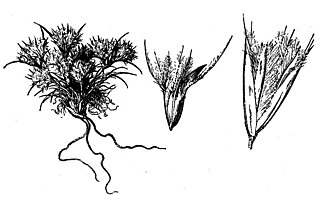
Blepharidachne is a small genus of New World plants in the grass family, generally known as eyelashgrass or desertgrass..

Stipa parishii, formerly classified as Achnatherum parishii, is a species of grass known by the common name Parish's needlegrass. The Jepson Manual 2nd edition (2012) reclassified the plant as Stipa parishii var. parishii.
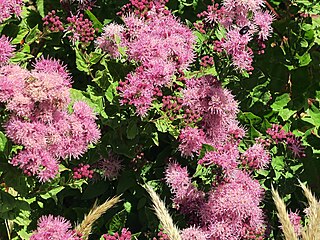
Ageratina occidentalis is a species of flowering plant in the family Asteraceae known by the common name western snakeroot or western eupatorium. It is native to the western United States where it grows in several types of habitat. It is found in California, Oregon, Washington, Idaho, Montana, Nevada, and Utah.

Agrostis idahoensis is a species of grass known by the common name Idaho bent grass. It is native to western North America from Alaska to California to Colorado, where it grows in several habitat types.

Chaenactis macrantha is a species of flowering plant in the daisy family known by the common names bighead dustymaiden and Mojave pincushion. It is native to the Great Basin and the southwestern deserts of the United States, in California, Arizona, Utah, Nevada, southwestern Idaho, and southeastern Oregon. It grows in dry, open habitat with gravelly, sandy soils, often calcareous or alkaline in nature.

Cleomella plocasperma is a species of flowering plant in the cleome family known by the common name twisted cleomella and alkali stinkweed. It is native to the Great Basin and Mojave Desert in the western United States, where it grows mainly in wet, alkaline soils such as those around hot springs. There is a disjunct population in the Bruneau Valley of southwestern Idaho. It grows with other halophytic species such as saltgrass and greasewood. This is an annual herb producing a smooth, hairless stem which divides into several erect or upright branches which may exceed half a meter tall. The sparse leaves are each split into three narrow leaflets. The flowers occur in a raceme at the top of each stem branch. Each flower has four yellow petals and several long stamens which may be over a centimeter long. The fruit is a capsule with large lobes. It hangs at the tip of the remaining flower receptacle.

Crepis occidentalis is a North American species of flowering plant in the family Asteraceae known by the common names western hawksbeard, or largeflower hawksbeard. It is native to western Canada and the western United States.
Erythranthe inflatula, synonyms Mimulus inflatulus and Mimulus evanescens, is a rare species of monkeyflower known by the common name disappearing monkeyflower. It is native to the western United States, where it is known from about ten locations in and around the Great Basin within the states of Idaho, Oregon, and California; it is also found in Nevada. Specimens of the plant had been catalogued as Mimulus breviflorus, but on further examination it was evident that they were a separate, unclassified species; this was described to science in 1995. It is thought that the plant may have evolved via hybridization between Erythranthe breviflora and Erythranthe latidens, or that it evolved from E. latidens and then into E. breviflora.

Muhlenbergia porteri is a species of grass known by the common names bush muhly and Porter's muhly.

Orobanche californica, known by the common name California broomrape, is a species of broomrape. It is a parasitic plant growing attached to the roots of other plants, usually members of the Asteraceae.
Plagiobothrys kingii is a species of flowering plant in the borage family known by the common name Great Basin popcornflower. It is native to the Great Basin and Mojave Desert of the United States, where it grows in desert and plateau scrub habitat, among saltbush and on rocky slopes and flats.
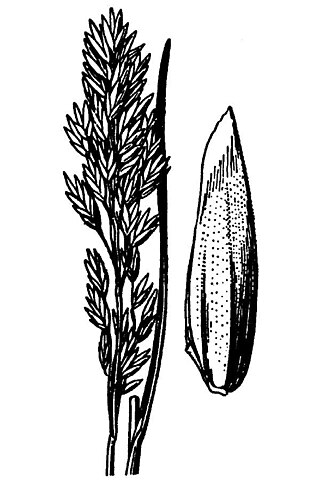
Poa cusickii is a species of grass known by the common name Cusick's bluegrass. It is native to western North America from Yukon to Colorado to eastern California, where it grows in many types of habitat, including high mountain meadows and slopes, sagebrush scrub, and forests.
Ptilagrostis kingii is a species of grass known by the common names Sierra false needlegrass and King's ricegrass. It is endemic to the high mountains of the Sierra Nevada of California, where it grows in meadows and near streams in subalpine and alpine climates.

Ribes velutinum is a species of currant known by the common name desert gooseberry.
Sisyrinchium halophilum is a species of flowering plant in the family Iridaceae known by the common name Nevada blue-eyed grass. It is native to the western United States in and around the Great Basin and Mojave Desert, where it grows in moist, often highly alkaline habitat, such as seeps, meadows, and mineral springs.
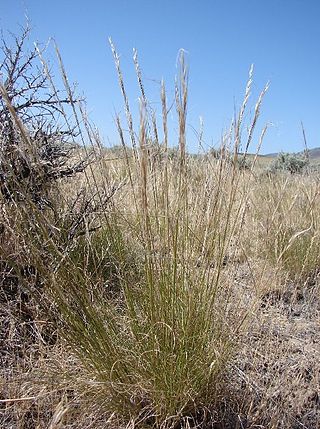
Achnatherum thurberianum is a species of grass known by the common name Thurber's needlegrass. It is native to the western United States, where it occurs from Washington to California and east to Montana and Wyoming.
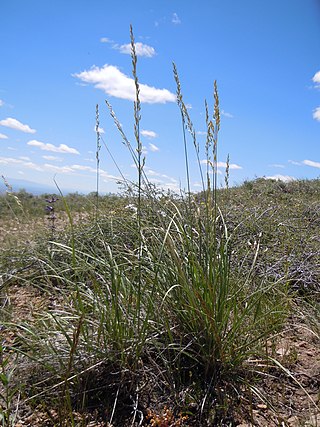
Leucopoa kingii is a species of grass known by the common names spike fescue and King's fescue. It is native to the western United States from Oregon and California east to Nebraska and Kansas.
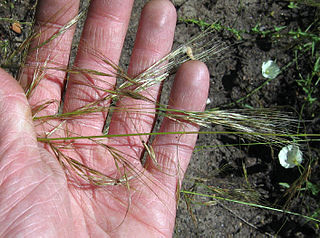
Nassella lepida is a species of grass known by the common names foothill needlegrass, foothills nassella, foothill stipa, small-flowered stipa, small-flowered needlegrass, and smallflower tussockgrass.

Physaria kingii is a species of flowering plant in the family Brassicaceae known by the common name King bladderpod. It is native to western North America from Utah to Baja California, where it grows in dry and rocky habitat, such as deserts and adjacent mountain slopes. This is a perennial herb growing a small, hairy stem from a caudex. The leaves form a patch or rosette around the caudex, each up to 6 centimeters long and round, oval, diamond, or spoonlike in shape. The inflorescence is an erect or mostly upright raceme of bright yellow mustardlike flowers. The fruit is a hairy capsule under a centimeter long suspended on a short, often curvy pedicel.

















